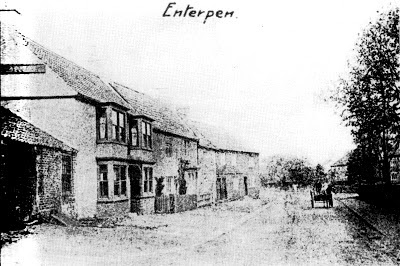There is an interesting and close link between the Wilson family, who owned the Hutton Rudby sailcloth mill,
 |
| Hutton Mill, seen from the Rudby side of the river |
and the Newcastle painter and artist, Ralph Hedley (1848-1913), many of whose paintings can be seen in the
Laing Gallery.
For years Hedley was out of fashion and his paintings were destroyed or thrown away – but more recently they have come back into favour as a record of ordinary life in the North East in the late 19th century.
George Wilson, founder of the family linen business at Hutton Rudby, had four sons and one daughter.
The eldest, James Alder Wilson, became Rector of Crathorne. The youngest, John George Wilson, after excelling as an athlete at school and at Oxford, became a solicitor in Durham. He inherited Staindrop Hall, on the condition that the family surname was changed to Luxmoore. Allan Bowes Wilson and Thomas Bowes Wilson, the second and third sons, took over the sailcloth manufactury on their father’s death.
-.jpg) |
| Allan Bowes Wilson, c1903 |
Thomas married and lived at Enterpen Hall.
Allan – though gossip has it that he kept a mistress in the village – never married and lived with his unmarried sister Annie in Hutton House, on the Green.
John George Wilson (1849-c1930) was Ralph Hedley’s solicitor, friend and patron. He was a keen buyer of Hedley’s paintings and carved furniture and recommended the artist to friends.
Ralph Hedley lived in Newcastle from the age of two, but he had been born at Gilling West near Richmond and he returned to the North Riding as often as he could – Runswick Bay was a favourite destination. He specialised in scenes of ordinary working life, using his sketchbook and making notes in preparing his paintings, and also even taking photographs.
Allan Bowes Wilson (c1839-1932) also collected Hedley’s work.
He commissioned Hedley to paint the Bilsdale Hunt, arranging with him by letter to meet several of the huntsmen at Spout House, Bilsdale. I don’t know how the picture came to be used as an advertisement for
Bovril, but I believe the artist wasn’t very happy.
 |
| 'Counting the Bag' |
The nearby Sun Inn was also the setting for Hedley’s 'Counting the Bag' which was painted in 1902 and bought by Allan Bowes Wilson.
Another of Hedley’s works, ‘The Brickmakers’, was painted somewhere near Hutton Rudby:
 |
| Sketch for 'The Brickmakers' |
John Millard’s book ‘Ralph Hedley: Tyneside Painter’ is only available second hand at the moment, so I hope he'll forgive me including the sketch for ‘The Brickmakers’ which features as an illustration in his book.
It has been suggested that the scene depicted is somewhere near Faceby Manor, but perhaps one of you will have a better idea?
Many thanks to Clodagh Brown, great-granddaughter of Ralph Hedley, who contacted me to tell me of this fascinating link and for all her information.
For more on the Wilson family, see this blogpost on
James Wilson, the founder of their fortunes.










-.jpg)


